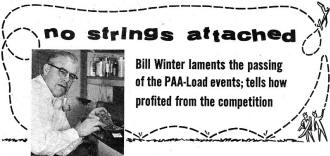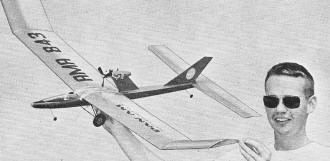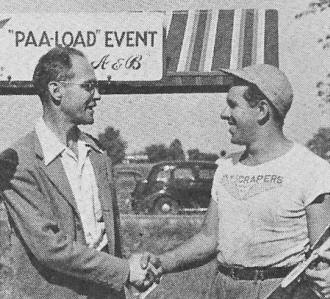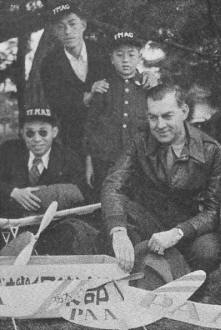|
In this December 1961 issue of American Modeler magazine, editor Bill Winter
laments the termination of
Pan American Airways' (PAA) sponsorship of the popular
PAA-Load contesting event. For the previous 14 years, Pan Am underwrote expenses
and created, monitored, wrote the rules for, publicized, convened contests, and
awarded prizes for an aspect of model airplane building and flying meant to
encourage youngsters to be involved in the design, flying and strategic planning
of creating a platform which would carry large amounts of weight at low power.
According the Mr. Winter, the PAA-Load event might have been too successful for
its own good. As with most kinds of competitions with high participation,
dedicated participants finely tuned their designing, building, and flying skills
to the point where newcomers and those with limited resources could not
effectively compete anymore. The same is true to some extent for R/C and C/L
scale, aerobatics, soaring, and free flight. Little did Bill know that before
then end of the decade, the
U.S. Navy would ends its decades-long relationship with the Academy of Model
Aeronautics (AMA) as it no long saw a benefit of attracting young men - future
Navy members - due to the waning participation of younger modelers in the
Nationals.
No Strings Attached - The Demise of PAA-Load Competitions
 Bill Winter laments the passing of the PAA-Load
events; tells how profited from the competition Bill Winter laments the passing of the PAA-Load
events; tells how profited from the competition
Hang the flag at half-mast. The PAA-Load events are no more. So accepted a part
of competitive modeling life had these became, their untimely end brings shock and
confusion to us all. Why did Pan American terminate its sponsorship?
Well, one can expect that the red-ink year for most all the airlines might have
been a factor in making the carrier take a long hard look at its promotions, This
is the way of such things - witness the demise of the truly costly Plymouth program
which offered eliminations, free trips to Detroit, and an "Internationals" that
almost, but never quite vied with the Nationals in scope and importance. When the
Chrysler Corporation had experienced a rough period a program that in its first
year received more publicity than Chevrolet's long-promoted Soap Box Derby stopped
as abruptly as a "frozen" engine. When income and taxes are high, companies spend
more freely. For Plymouth (Chrysler) the yearly costs of the modeling program shot
upwards past six figures like an Atlas missile piercing a cloud. Since the costs
of the PAA-Load program were extremely modest by comparison, we may assume some
other conditions existed.
The plain truth of the matter is that Pan American's program, through nobody's
fault, was failing more and more to appeal to the kids. Had the youngsters responded
in important, even increasing, numbers, it is quite probable that Pan American would
have gone on. Their Mini-Jet event took dead aim at the young fry, after regular
PAA-Load (both jet and .02 glow engine) and Clipper Cargo events proved that existing,
more-or-less expert modelers - many of them grown-ups - simply branch out to win
more prizes.

Stellar performance by Don Burke of SLOW Club (and East Hartford,
Connecticut): his 02 Cox powered original Clipper Cargo set 67 1/2 ounce "lift" record.

George Gardner at Olathe Nats.
Officially, Dallas Sherman tells us that Pan Am's program had accomplished what
it had set out to achieve but that, from an airline point of view, today's space
age rendered doubtful the future effectiveness of PAA's program to. stimulate small-fry
interest in aeronautics. This may seem true to our airline friends but the writer
holds another opinion.
It is a moot question why we can't get more kids out to contests, especially
the Nationals. For one thing, younger flyers find it difficult if not impossible
to travel to meets, unless an adult takes them. Pop has to use up his vacation
to furnish the two weekends (including travel time) required to see through the
Roman Circus, dawn-to-dusk, triple-header that we fondly term a Nats. And what can
he do about Ma and Sis who prefer to be at the shore or in the mountains?
Why should we expect kids to attend local meets when so few clubs make any effort
much less offer an effective program to lure youngsters into competitive modeling?
Actually, more under-16's than ever are building model airplanes, but you'd never
know it from our contests. Re Pan American ... just how much support did we all
give them?
Any corporate-sponsored program must be justified. In general, a company likes,
may even expect, to see its name in print. (We once watched the Chrysler-Plymouth
brass view a TV program - an interview with Mom Robbers (Coad) at the Internats
- and from the happy comments assumed that Ford and GM had just surrendered.) Whether
or not an airline expects more people to ride its planes because of such programs,
we cannot say, though this logically is the end product of getting your name in
print.
More specifically, the program must have worthwhile aims and objectives. Any
plan proposed by lower-echelon specialists or enthusiasts must have substance to
win management approval. Its batting average must stay high to maintain that approval
year after year. No one will ever say to the AMA, "Here boys, take this bag of gold
and spread it around because we love you."
When the PAA-Load events were launched in 1948 at the Olathe, Kansas, Nationals,
the Class A and B free flights had to carry weighted dummies. Whereas most models
were being flown competitively for single performance absolutes, such as how much
duration a lucky thermal gave you, or how fast a cleverly doctored speed engine
and secret brew would propel a model wired to a human pylon, the PAA-Load job reminded
us that the prime purpose of an airplane is to carry something from here to there.
After the early payload ships developed into just heavier free flights, Pan Am
raised their sights with Clipper Cargo, a truly delightful, fascinating event which,
alas, in the end attracted a small but earnest band of engineers, scientists, and
assorted "brains" on vacation. And, of course, it wasn't always easy to provide
takeoff strips at "grass-roots" meets. As the .049-powered cargo jobs grew into
cumbersome giants ... to everybody's amazement - these special-event freaks could
not be flown for anything else, certainly not for fun, and the changed rules then
created the remarkable .02 cargo jobs we have today (which still can't be flown
for fun). The old A and B payload gassies faded into oblivion.
A scientific success and the thinking-modeler's delight, the cargo jobs took
Pan Am farther away than ever from their avowed goal of stimulating air youth activity.
One wonders how Dallas and his Pan American companion-in-arms, George Gardner, managed
to get budget approval year after year, when curious management kept spotting all
the "old boys" in the pictures turned in by their photogs. If Dad wonders what he
looked like when he had hair, Pan Am probably can show him.
Or do you suppose that some puzzled vice president asked how come we sponsor old-fashioned
prop-driven models in this jet age? (Do you suppose Pan Am now plans space routes?)
So Dallas came up with rules for jet models.
Somehow, we suspect, Jetex power did not bear the same relationship to jetliner
turbines that a gas engine bore to twin-row radials. To be technically exact, Jetex
is not "jet," but a perfectly safe "rocket" and is penalized like all rockets by
short duration and limited amount of thrust.
Over the 14 seasons that the Pan American events existed, the rules, subject
to influences that did not exist for standard AMA events, had become too forced
and restrictive for their own good. (Don't ask us to prove this Monday-morning-quarterback
opinion.) Maybe the rules just never had the chance they deserved.
What can we salvage from all this? What have we learned from the experience?
With what knowledge can we face similar future problems?
Probably the most conspicuous thing about the Pan-Am events was their near-independence
of AMA rules and authority. There is a great principle involved here. Should the
AMA require that outside support and sponsorship be confined to existing standard
events, or should they trade with any and all industrial sponsors who offer support
provided that the prospective sponsor can set up his own event and rules? The Hiller
Helicopter category is another conspicuous example ... and we might say, almost
total failure. Pan American - admittedly a friend and staunch AMA supporter - had
to evolve a complex regs structure that required its own yearly rules book.
It seems transparently clear that AMA, in the future, should cut off independent
event sponsorship. We have too many events. Worse yet, we have an obsession about
running nearly every AMA category at every Nationals, probably dating back to the
American Legion sponsored debacle at Minneapolis in 1947. The "full-week" Nats has
become a top-heavy affair that exists only because of the resources of the U. S.
government. Were the Navy support to vanish - and who knows when or what world conditions
will bring interruption or termination - what then? Certainly some who have watched
the outdoor hand-launched glider event (for one example) on a windy day, with a
truck load of Navy personnel timing the many flights, must wonder about the prodigious
demands of the whole vast meet in terms of man-hours. Why, we ourselves are hurting
at the yearly effort. Many of the wonderful leader members who for years ironed
out processing and so on, reluctantly have had to put their well being before the
wear and tear of the insane marathon. Perhaps Navy will think it easier to fight
a brush-fire war than man a Nats?

Dallas Sherman at Japan meet for rubber-powered PAA-Load.
So, while we'd much prefer to have Pan Am with us always, it does seem, nevertheless,
that the picture event-wise has been eased just a bit.
Don't misunderstand us ... Pan Am's events offered much that was good. Thanks
to Dallas Sherman who persistently stuck to his point that model planes should bear
some performance relationship to the real thing, we have all become more design
conscious. Load-carrying requirements added something to free flight. The Clipper
Cargo event in particular was especially fascinating, the models spectacular in
their capabilities - witness the surprising developments in .049 gas that caused
PAA to switch to the supposedly less potent .02's. Load designs accomplished things
thought impossible. They opened eyes ... and doors in the mind. Cargo was a thrill
to watch even if most of us left the weight-lifting to the Larry Conovers and, the
C. O. Wright's. Lord knows, we have a surfeit of fun events.
Must we always fly for fun alone? Are we so far gone in this accelerating age
that the problems of simple model airplane design must be removed before we condescend
to compete with our quickie crates? Must we never have anything invigorating or
worthwhile, nothing that inspires, stimulates or contributes knowledge? Clipper-Cargo
could continue under AMA aegis. If so, we might forget the straight payload jobs
(the existing AMA "rocket" event would cover for Mini-Jet and PAA-Load jet). If
the rules are not what they should be, the usual rules-making procedures are available.
It will be a lasting disgrace to permit the world of PAN AM events to sink without
trace beneath a Sargasso Sea of fun-fun-fun.
We don't know about your reaction to Pan American's decision, but we feel as
if we had been struck by lightning. The subtraction of these challenging events
leaves a painful void. Hundreds, if not thousands, of modelers, many grown to manhood
during the 14 years that Pan American carried the ball, have their special memories
and are, perhaps, better men for the experience. Dallas Sherman and George Gardner
have made countless friends ... personally and for Pan Am.
It will seem strange not to have them at our major meets.
Posted December 7, 2019
|



